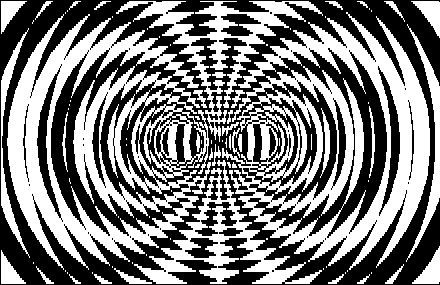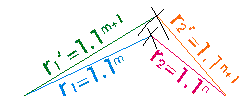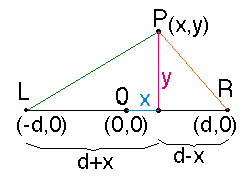 |
|
Their radii are 1.1^n where n are integers. If the families of circles were arithmetically spaced,
I had asked in sci.math if the Moirés are circles in these exponentially spaced circles. Chas Brown replied with this explanation: D(f1,p)/D(f2,p) = k, k constant.
The "next intersection" in the Moire pattern will be at
thus r1'/r2' = r1/r2 If you take your Moire pattern "to the limit", you're looking at two
circle families, centered say at (-d, 0) and (d,0). Let the family of circles
have radii u^n, n an integer, and u>1.0. As u gets very close to 1, the
sucessessive steps in the pattern get smaller, but we still get the same
pattern noted above (imagine u = (1.1)^(1/1000)); same pattern, with 1000
intervening steps). As u approaches 1, the Moire paten becomes the family
curves, each of which is the locus of points with radii to the respective
generating circles in a fixed ratio, say c.
where c is the fixed ratio of LP/PR (here I'm assuming c>1), and d is
the distance of the generating circles from the origin. We can then expand
this to:
since c is a constant, let k = (c&2+1)/(c^2-1); k > 1 since 1 < c < infinity, then y^2 + x^2 - 2*k*d*x + d^2 = 0
so y^2 + (x - k*d)^2 = (k^2-1)*d^2 is the equation of the family of circles you see, with 1 < k < infinity. The same follows if we choose c < 1; in that case k has range
|
|
|

